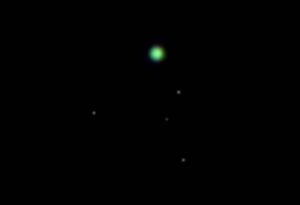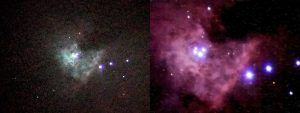January 24, 2017
Viewing with the Great Equatorial Telescope – 24 January 2017
Report by: Tej Dyal

The planet Uranus on the evening of 24th Jan 2017, captured using the Great Equatorial Telescope at the Royal Observatory by Tom Kerss
For the third time in a row, our Flamsteed observation sessions on the Great Equatorial Telescope were blessed with clear skies and, once again, one of our ROG Astronomers maximised the opportunity to making it a night to remember for our Flamsteed members.
This time around, it was ROG’s own ‘rock star’ astronomer, Tom Kerss whom with much enthusiasm and energy, whisked us on a tour of some fascinating celestial targets.
On arrival, Tom had the 28″ Refractor pointed at Uranus whilst also feeding a live high quality video image of it on two wall monitors via a camera mounted on the six inch finderscope. The live images of the night’s targets was a wonderful touch, particularly on Uranus whose distinct green tones were so vivid. To our surprise, Uranus was almost equally vivid in its colour through the eyepiece too. We could very easily observe its spherical appearance, thanks to the 425X magnification of the huge refractor and 20mm eyepiece. It’s quite a sensation considering this planet is the second furthest away from us at 3 billion km. At the start of this observation, Tom commenced an epic talk starting with how Uranus was observed several times by astronomers, including John Flamsteed, but had mistaken it for a star. It was eventually re-discovered as a planet by William Hershel in 1781 even though he initially thought was a comet!
After we had our fill and belches of the gaseous planet, Tom navigated the telescope towards Vesta, one of two of the biggest asteroids in the asteroid belt. Although observable as just a small point of light, due to the sunlight reflecting off the rocky surface, it was very bright in the eyepiece with a nice yellow tint. The asteroid is measured to be 525 km. Tom describes how Vesta, along with the largest asteroid, Ceres, were visited and orbited by NASA’s great spacecraft, DAWN. An astounding achievement in which researchers are still ploughing through the data to reveal more on how the solar system was formed. Now I had thrown out a “fact” to some poor innocent members that Vesta was a dwarf planet. I was wrong! Slap on my wrist and wherever else I should be slapped. Tom corrects my erroneous assumption by explaining that because Vesta is an irregular shape, it is categorised as a minor planet. Ceres, the largest asteroid, has enough mass to gravitationally collapse and form into a spherical object thus qualifying it as a dwarf planet.
Tom then slewed the telescope onto our final target, the Great Orion Nebula. Wow. What a showstopper this was. There were certainly a few gasps from the members, including myself. We observed a cradle of new born baby stars (only a few million years old!) in the formation of a trapezium, bathed in a gloriously wispy cloud of nebulosity. A strikingly beautiful sight that almost looked like the photographic images we saw on the monitors. Some members with acute eyesight could also make out a binary system on one of the stars in the trapezium. Tom described this nebula as a stellar nursery of which several hundred stars have been observed in various stages of their lives. The nebula itself spans for 20 light years but most of the stars within it are clouded by the nebula to be observed visually hence why we just see just a few of the very bright blue giant stars such as those we observed in the form of the trapezium. This nebula turned out to be our final target for one simple reason. No, not because time ran out, we had plenty of that remaining…it’s because we couldnt get enough of it! As we lingered on it longer, more details popped out as the strands of the nebula just grew and grew and some of us couldn’t help having second helpings of it.
Once Tom wrapped up his enjoyable talk and unforgettable tour through the 28 inch refractor, we thanked him profusely for his quality time which he freely and enthusiastically gave to us.
If you would like to discuss/chat or ask questions about our events or anything about astronomy, or share your own astronomy related experience, please do come and ask/chat away on our members forum at http://www.flamsteed.org.uk/forums/
Posted under: 28-Inch Equatorial Viewing, Flamsteed, Meeting Report


You must be logged in to post a comment.